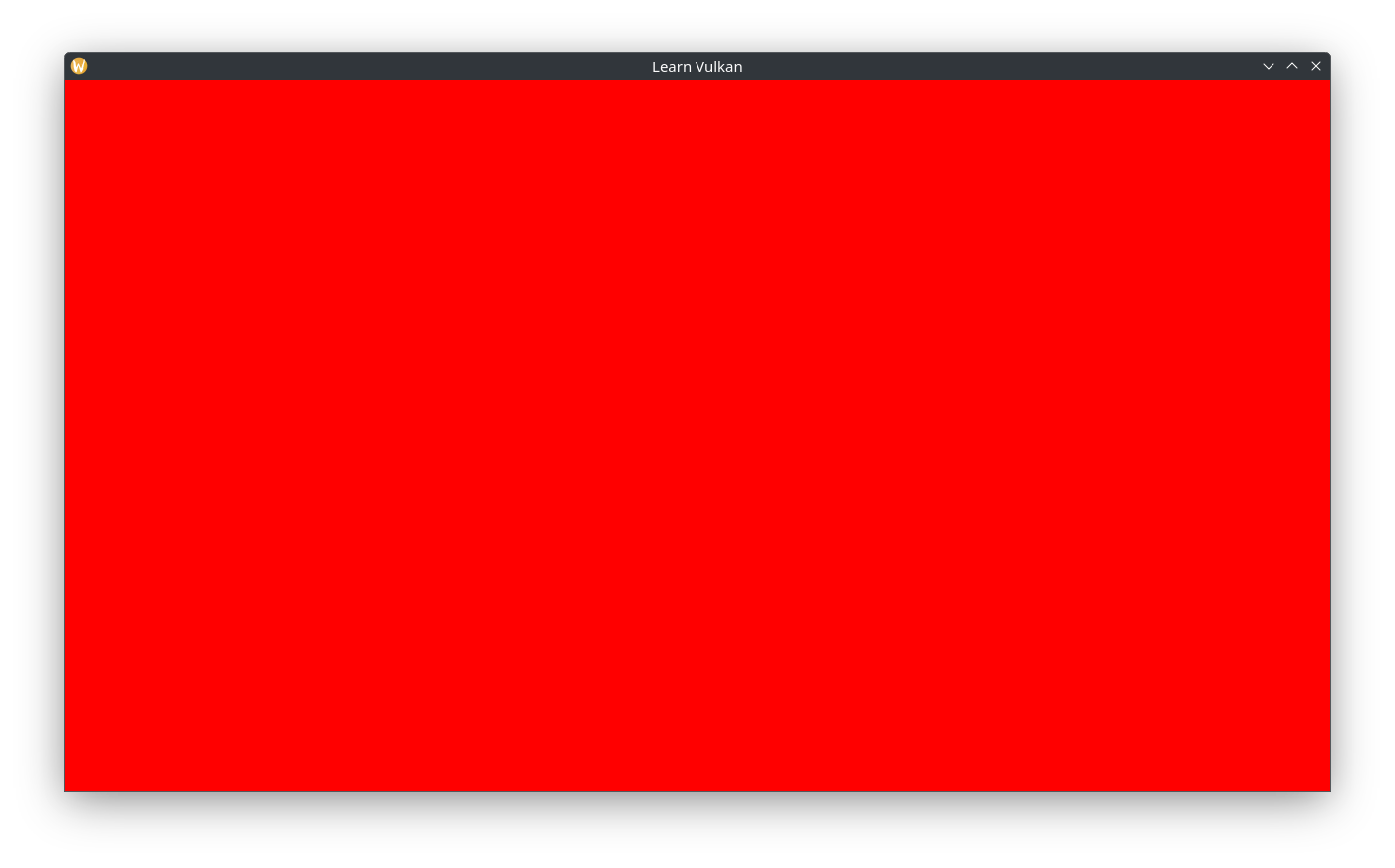Dynamic Rendering
Dynamic Rendering enables us to avoid using Render Passes, which are quite a bit more verbose (but also generally more performant on tiled GPUs). Here we tie together the Swapchain, Render Sync, and rendering. We are not ready to actually render anything yet, but can clear the image to a particular color.
Add these new members to App:
auto acquire_render_target() -> bool;
auto begin_frame() -> vk::CommandBuffer;
void transition_for_render(vk::CommandBuffer command_buffer) const;
void render(vk::CommandBuffer command_buffer);
void transition_for_present(vk::CommandBuffer command_buffer) const;
void submit_and_present();
// ...
glm::ivec2 m_framebuffer_size{};
std::optional<RenderTarget> m_render_target{};
The main loop can now use these to implement the Swapchain and rendering loop:
while (glfwWindowShouldClose(m_window.get()) == GLFW_FALSE) {
glfwPollEvents();
if (!acquire_render_target()) { continue; }
auto const command_buffer = begin_frame();
transition_for_render(command_buffer);
render(command_buffer);
transition_for_present(command_buffer);
submit_and_present();
}
Before acquiring a Swapchain image, we need to wait for the current frame's fence. If acquisition is successful, reset the fence ('un'signal it):
auto App::acquire_render_target() -> bool {
m_framebuffer_size = glfw::framebuffer_size(m_window.get());
// minimized? skip loop.
if (m_framebuffer_size.x <= 0 || m_framebuffer_size.y <= 0) {
return false;
}
auto& render_sync = m_render_sync.at(m_frame_index);
// wait for the fence to be signaled.
static constexpr auto fence_timeout_v =
static_cast<std::uint64_t>(std::chrono::nanoseconds{3s}.count());
auto result =
m_device->waitForFences(*render_sync.drawn, vk::True, fence_timeout_v);
if (result != vk::Result::eSuccess) {
throw std::runtime_error{"Failed to wait for Render Fence"};
}
m_render_target = m_swapchain->acquire_next_image(*render_sync.draw);
if (!m_render_target) {
// acquire failure => ErrorOutOfDate. Recreate Swapchain.
m_swapchain->recreate(m_framebuffer_size);
return false;
}
// reset fence _after_ acquisition of image: if it fails, the
// fence remains signaled.
m_device->resetFences(*render_sync.drawn);
return true;
}
Since the fence has been reset, a queue submission must be made that signals it before continuing, otherwise the app will deadlock on the next wait (and eventually throw after 3s). Begin Command Buffer recording:
auto App::begin_frame() -> vk::CommandBuffer {
auto const& render_sync = m_render_sync.at(m_frame_index);
auto command_buffer_bi = vk::CommandBufferBeginInfo{};
// this flag means recorded commands will not be reused.
command_buffer_bi.setFlags(vk::CommandBufferUsageFlagBits::eOneTimeSubmit);
render_sync.command_buffer.begin(command_buffer_bi);
return render_sync.command_buffer;
}
Transition the image for rendering, ie Attachment Optimal layout. Set up the image barrier and record it:
void App::transition_for_render(vk::CommandBuffer const command_buffer) const {
auto dependency_info = vk::DependencyInfo{};
auto barrier = m_swapchain->base_barrier();
// Undefined => AttachmentOptimal
// the barrier must wait for prior color attachment operations to complete,
// and block subsequent ones.
barrier.setOldLayout(vk::ImageLayout::eUndefined)
.setNewLayout(vk::ImageLayout::eAttachmentOptimal)
.setSrcAccessMask(vk::AccessFlagBits2::eColorAttachmentRead |
vk::AccessFlagBits2::eColorAttachmentWrite)
.setSrcStageMask(vk::PipelineStageFlagBits2::eColorAttachmentOutput)
.setDstAccessMask(barrier.srcAccessMask)
.setDstStageMask(barrier.srcStageMask);
dependency_info.setImageMemoryBarriers(barrier);
command_buffer.pipelineBarrier2(dependency_info);
}
Create a Rendering Attachment Info using the acquired image as the color target. We use a red clear color, make sure the Load Op clears the image, and Store Op stores the results (currently just the cleared image). Set up a Rendering Info object with the color attachment and the entire image as the render area. Finally, execute the render:
void App::render(vk::CommandBuffer const command_buffer) {
auto color_attachment = vk::RenderingAttachmentInfo{};
color_attachment.setImageView(m_render_target->image_view)
.setImageLayout(vk::ImageLayout::eAttachmentOptimal)
.setLoadOp(vk::AttachmentLoadOp::eClear)
.setStoreOp(vk::AttachmentStoreOp::eStore)
// temporarily red.
.setClearValue(vk::ClearColorValue{1.0f, 0.0f, 0.0f, 1.0f});
auto rendering_info = vk::RenderingInfo{};
auto const render_area =
vk::Rect2D{vk::Offset2D{}, m_render_target->extent};
rendering_info.setRenderArea(render_area)
.setColorAttachments(color_attachment)
.setLayerCount(1);
command_buffer.beginRendering(rendering_info);
// draw stuff here.
command_buffer.endRendering();
}
Transition the image for presentation:
void App::transition_for_present(vk::CommandBuffer const command_buffer) const {
auto dependency_info = vk::DependencyInfo{};
auto barrier = m_swapchain->base_barrier();
// AttachmentOptimal => PresentSrc
// the barrier must wait for prior color attachment operations to complete,
// and block subsequent ones.
barrier.setOldLayout(vk::ImageLayout::eAttachmentOptimal)
.setNewLayout(vk::ImageLayout::ePresentSrcKHR)
.setSrcAccessMask(vk::AccessFlagBits2::eColorAttachmentRead |
vk::AccessFlagBits2::eColorAttachmentWrite)
.setSrcStageMask(vk::PipelineStageFlagBits2::eColorAttachmentOutput)
.setDstAccessMask(barrier.srcAccessMask)
.setDstStageMask(barrier.srcStageMask);
dependency_info.setImageMemoryBarriers(barrier);
command_buffer.pipelineBarrier2(dependency_info);
}
End the command buffer and submit it. The draw Semaphore will be signaled by the Swapchain when the image is ready, which will trigger this command buffer's execution. It will signal the present Semaphore and drawn Fence on completion, with the latter being waited on the next time this virtual frame is processed. Finally, we increment the frame index, pass the present semaphore as the one for the subsequent present operation to wait on:
void App::submit_and_present() {
auto const& render_sync = m_render_sync.at(m_frame_index);
render_sync.command_buffer.end();
auto submit_info = vk::SubmitInfo2{};
auto const command_buffer_info =
vk::CommandBufferSubmitInfo{render_sync.command_buffer};
auto wait_semaphore_info = vk::SemaphoreSubmitInfo{};
wait_semaphore_info.setSemaphore(*render_sync.draw)
.setStageMask(vk::PipelineStageFlagBits2::eColorAttachmentOutput);
auto signal_semaphore_info = vk::SemaphoreSubmitInfo{};
signal_semaphore_info.setSemaphore(m_swapchain->get_present_semaphore())
.setStageMask(vk::PipelineStageFlagBits2::eColorAttachmentOutput);
submit_info.setCommandBufferInfos(command_buffer_info)
.setWaitSemaphoreInfos(wait_semaphore_info)
.setSignalSemaphoreInfos(signal_semaphore_info);
m_queue.submit2(submit_info, *render_sync.drawn);
m_frame_index = (m_frame_index + 1) % m_render_sync.size();
m_render_target.reset();
// an eErrorOutOfDateKHR result is not guaranteed if the
// framebuffer size does not match the Swapchain image size, check it
// explicitly.
auto const fb_size_changed = m_framebuffer_size != m_swapchain->get_size();
auto const out_of_date = !m_swapchain->present(m_queue);
if (fb_size_changed || out_of_date) {
m_swapchain->recreate(m_framebuffer_size);
}
}
Wayland users: congratulaions, you can finally see and interact with the window!

Render Doc on Wayland
At the time of writing, RenderDoc doesn't support inspecting Wayland applications. Temporarily force X11 (XWayland) by calling glfwInitHint() before glfwInit():
glfwInitHint(GLFW_PLATFORM, GLFW_PLATFORM_X11);
Setting up a command line option to conditionally call this is a simple and flexible approach: just set that argument in RenderDoc itself and/or pass it whenever an X11 backend is desired:
// main.cpp
// skip the first argument.
auto args = std::span{argv, static_cast<std::size_t>(argc)}.subspan(1);
while (!args.empty()) {
auto const arg = std::string_view{args.front()};
if (arg == "-x" || arg == "--force-x11") {
glfwInitHint(GLFW_PLATFORM, GLFW_PLATFORM_X11);
}
args = args.subspan(1);
}
lvk::App{}.run();